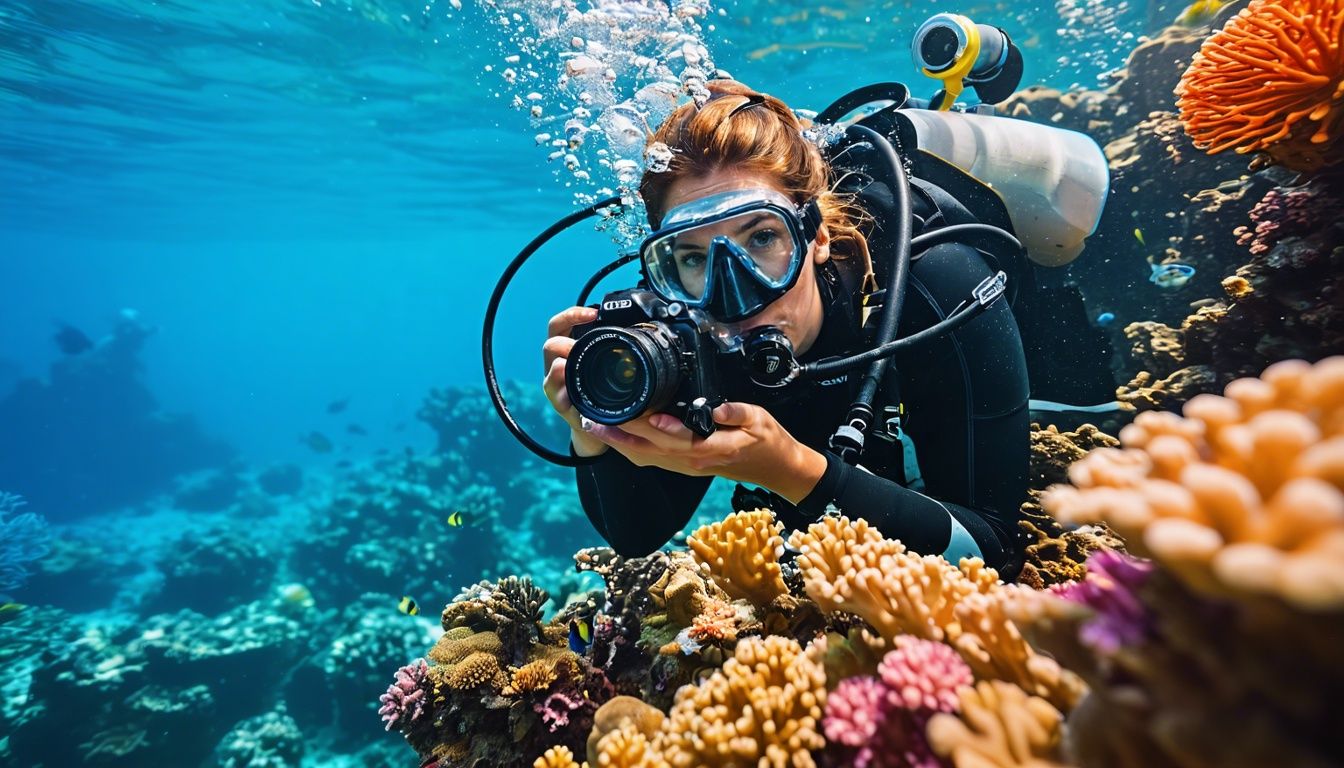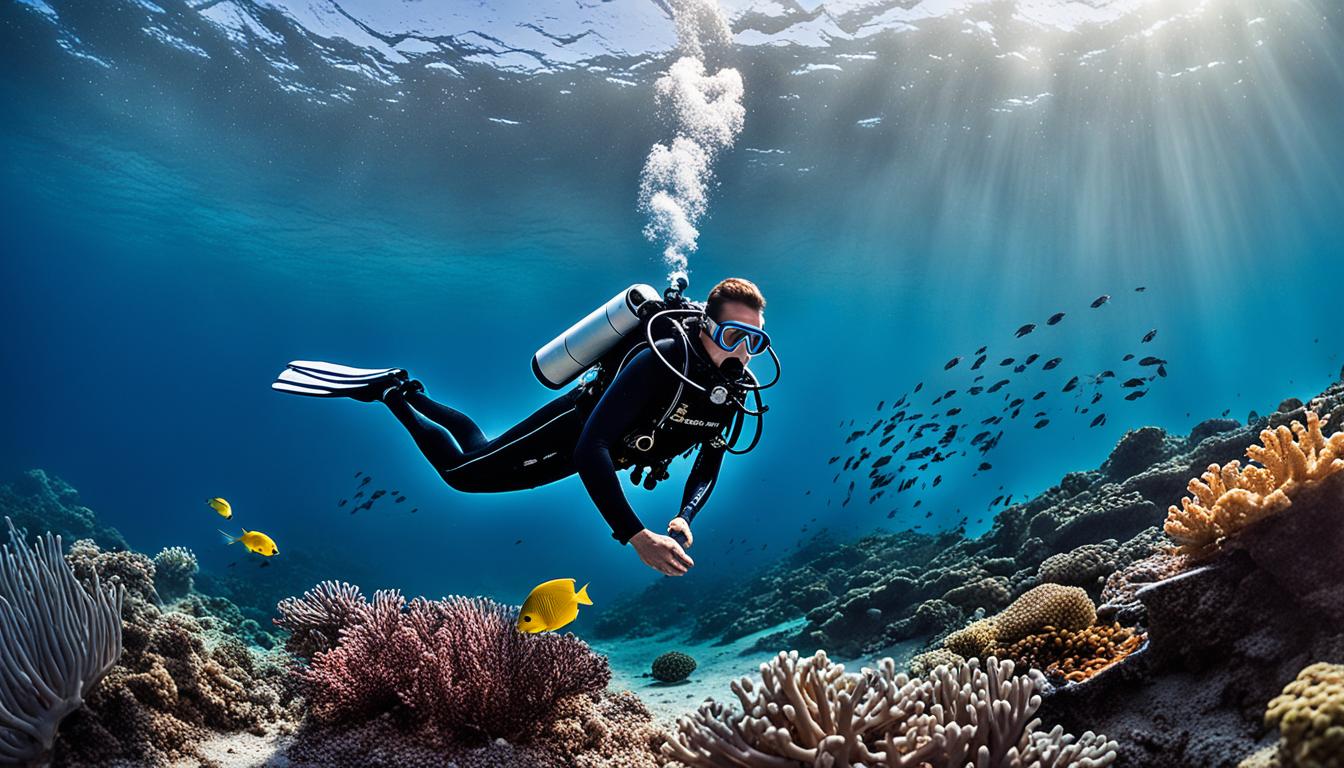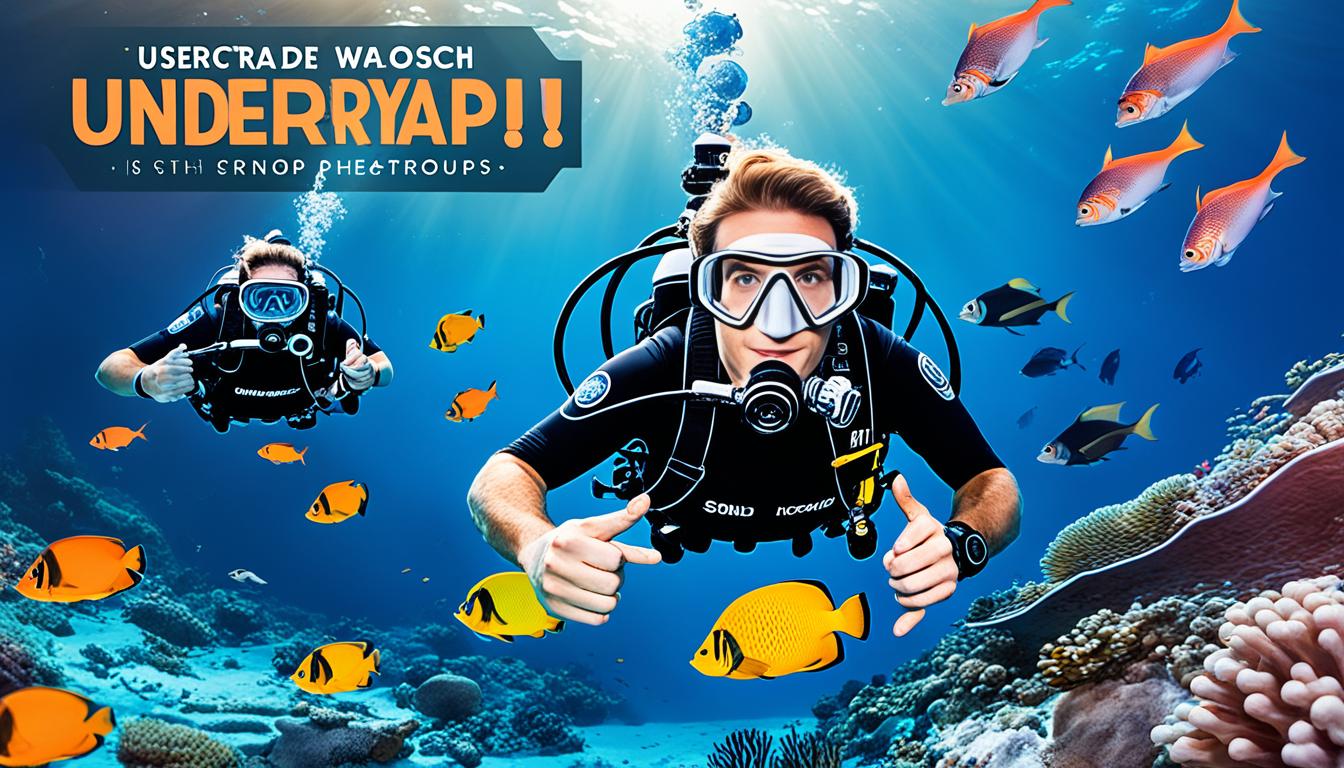When it comes to capturing the beauty of underwater scenes, mastering lighting techniques is essential. Whether you’re an underwater photographer, cinematographer, or filmmaker, understanding how to work with both natural and artificial light is crucial for achieving stunning results.
Underwater lighting presents unique challenges due to the limitations of available light and the underwater environment. However, with the right knowledge and techniques, you can overcome these challenges and create visually captivating images.
In this article, we will explore different lighting techniques specifically tailored to underwater photography, cinematography, and filmmaking. From utilizing natural light to making the most of artificial light and blending techniques, we’ll cover everything you need to know to master underwater lighting.
Key Takeaways:
- Underwater photography, cinematography, and filmmaking require mastering lighting techniques.
- There are three types of light used in underwater scenes: natural light, artificial light, and blended light.
- Understanding how to work with natural light and utilize filters is crucial for restoring color balance in underwater images.
- Artificial light, such as strobes, can help overcome challenges like backscatter and properly light subjects at various distances.
- Blended light techniques combine ambient light and strobe light to create a seamless balance in underwater images.
Utilizing Natural Light Underwater
In underwater photography, natural light plays a vital role in capturing the beauty of the underwater world. However, as we venture into deeper waters, the colors we perceive underwater tend to fade, appearing more blue. This shift in color can significantly impact the overall quality of our images. Fortunately, there are techniques we can utilize to restore the lost colors and bring back their vibrancy. One such technique involves the use of filters, which can help in color restoration, specifically for reds and oranges.
Filters serve as invaluable tools that help compensate for the color loss that occurs as natural light penetrates deeper water. By selectively filtering out certain wavelengths, filters restore the natural hues of the underwater environment, ensuring that our photographs accurately represent the awe-inspiring colors we witness while diving. These filters are available in various types and can be mounted on our cameras while we explore the depths.
The use of filters also eliminates the cyan cast that can be introduced when using strobe lighting. By solely relying on natural light and filters, we can capture stunning images that beautifully depict the underwater world in all its glory.
Making the Most of Artificial Light
Artificial light is a versatile tool in underwater photography, allowing us to capture stunning images in the depths. However, backscatter can be a common issue that affects the quality of our shots. Backscatter occurs when the light from our strobes hits particles in the water, resulting in white blobs that distract from the subject of our photos.
To avoid backscatter and achieve well-lit underwater images, we need to pay attention to two key factors: strobe position and strobe power.
Strobe Position
The position of our strobes plays a crucial role in minimizing backscatter. By positioning the strobes behind the dome port, we can reduce the chances of the light hitting particles directly. This placement helps create a clear and unobstructed path for the light to reach our subjects, resulting in cleaner and more vibrant images.
When it comes to strobe placement, there are several options depending on the desired outcome:
- Placing the strobes at nine and three o’clock positions, also known as the butterfly position, helps create even lighting and reduces shadows.
- Adjusting the strobes for vertical images allows us to illuminate the subject from both sides, emphasizing its shape and details.
“Proper strobe positioning is vital for achieving well-lit underwater images and minimizing the impact of backscatter.”
Strobe Power
The power of our strobes is another critical factor to consider. Adjusting the strobe power allows us to control the amount of light emitted and avoid overexposure or underexposure in our photos. By finding the right balance, we can ensure that our subjects are appropriately lit and that the surrounding water appears natural and clear.
Different strobes have various power settings, typically adjustable in increments. Experimenting with different power levels and reviewing the results will help us determine the optimal setting for a particular shot. It’s important to note that strobe power may need to be adjusted based on factors such as subject distance, water conditions, and desired creative effects.
Another useful tool to reduce backscatter is a dome diffuser. Dome diffusers soften the light and help distribute it more evenly, minimizing the intensity of backscatter in our images. Using a dome diffuser in conjunction with proper strobe positioning and power adjustment can greatly enhance the quality of our underwater photos.
Summary
Artificial light offers us a wealth of opportunities to capture remarkable images in the underwater realm. By mastering proper strobe positioning and power adjustment, we can avoid backscatter and create well-lit photographs that showcase the beauty of this unique environment.
The Art of Blended Light
Blended light techniques in underwater photography involve the skillful combination of ambient light and strobe light to create a balanced and seamless look in images. This technique is particularly effective in wide-angle photography and close focus wide angle (CFWA) photography, where a small subject in the foreground is captured along with the surrounding environment. The goal is to blend all the light sources harmoniously, making the image appear as one cohesive picture.
Blending ambient light and strobe light underwater requires careful consideration of strobe positioning and power adjustment. By positioning the strobes strategically and fine-tuning their power settings, photographers can achieve stunning blended light effects that add depth, dimension, and visual interest to their underwater photographs.
Wide-angle photography is especially well-suited for blended light techniques. By incorporating the natural light from the environment with carefully placed strobes, photographers can capture the expansive beauty of underwater scenes while ensuring their subjects are properly exposed. Blending light sources in this way adds a touch of magic to the images, enhancing the overall visual impact.
In close focus wide angle (CFWA) photography, where capturing a small subject in the foreground against the backdrop of the underwater landscape is the objective, blended light techniques are a powerful tool. By skillfully blending ambient light with strobe light, photographers can bring the entire scene to life, creating a sense of harmony and balance in the image.
Incorporating blended light techniques underwater requires both technical expertise and artistic vision. The right strobe positioning, coupled with a keen understanding of how to adjust strobe power, is key to achieving the desired effect. With practice and experimentation, photographers can develop their own unique style and master the art of blended light in underwater photography.

Expert Tip: Strobe Positioning and Power Adjustment
“When using blended light techniques, consider positioning your strobes at different angles to achieve a more natural and three-dimensional lighting effect. Experiment with strobe placement at nine and three o’clock positions, or adjust them for vertical images to create dynamic lighting. Additionally, adjusting the power of your strobes can help achieve optimal exposure and avoid overexposing your subjects.”
The Magic of Blended Light in Underwater Photography
Blended light techniques are a powerful tool for underwater photographers, allowing them to unleash their creativity and capture stunning images. Whether it’s wide-angle photography or close focus wide angle (CFWA) photography, the art of blending ambient light and strobe light adds depth, dimension, and a touch of magic to underwater scenes. By mastering the art of blended light, photographers can elevate their underwater photography to new heights.
Factors Affecting Underwater Lighting
When capturing stunning underwater images, it’s essential to consider the various factors that can affect the quality and characteristics of underwater lighting. Understanding these factors allows us to plan our shots and lighting setups effectively, resulting in exceptional underwater photographs.
Depth
One of the most significant factors impacting underwater lighting is depth. As we descend into the water, light absorption increases, leading to a reduction in brightness and color. The deeper we go, the more pronounced this effect becomes. To compensate for this loss of color and luminosity, it’s crucial to understand the color shift that occurs at different depths and adjust our lighting accordingly.
Subject Distance
The distance between our camera and the subject also plays a crucial role in underwater photography. Water density and particles in the water can reduce contrast and sharpness in images, particularly when shooting subjects at a distance. By getting closer to our subject, we minimize the impact of these factors and ensure that our lighting captures the desired level of detail and clarity.
Weather Conditions and Surface Conditions
In addition to depth and subject distance, weather and surface conditions can significantly affect underwater lighting. Sunlight angle and water clarity play vital roles in the amount of light that penetrates the water. Depending on the weather conditions and the time of day, the quality and intensity of underwater lighting can vary significantly. It’s essential to adjust our lighting techniques as per the prevailing weather and surface conditions to achieve optimal results.
“Understanding the factors that affect underwater lighting allows us to anticipate challenges and make the necessary adjustments to our technique. By adapting our lighting to ensure proper exposure, color reproduction, and contrast, we can capture the captivating beauty of underwater scenes.”
To further illustrate the impact of these factors on underwater lighting, let’s take a look at the following table that summarizes their effects:
| Factor | Effect on Underwater Lighting |
|---|---|
| Depth | Reduced brightness and color due to increased light absorption |
| Subject Distance | Decreased contrast and sharpness, particularly at longer distances |
| Weather Conditions and Surface Conditions | Varied light intensity and quality, depending on sunlight angle and water clarity |
The Quality of Light in Underwater Photography
The quality of light plays a vital role in creating impactful images in underwater photography. To capture stunning shots, we need to consider the brightness, color, and softness of the light. Let’s explore how each of these factors contributes to the visual appeal of underwater photographs.
Brightness: Achieving Well-Exposed Shots
Brightness, or the intensity of light, is essential in underwater photography. As we descend into deeper waters, natural light becomes scarce, making it necessary to supplement with artificial lighting sources. By properly adjusting the exposure settings and using additional light sources, we can ensure that our underwater shots are well-lit and visually pleasing.
Light Color: Restoring Natural Hues
Light color underwater is influenced by the selective absorption of different wavelengths in water, leading to a shift towards blue tones. This color shift can affect the vibrancy and accuracy of the captured images. To restore natural hues, we can utilize filters and colored lights. These tools help counteract the color loss and bring back the true colors of the underwater world, resulting in more captivating photographs.
Light Softness: Creating Effects and Moods
The softness of light refers to how it interacts with the underwater environment, affecting shadows and contrast in the images. Understanding and manipulating light softness can help us create different effects and moods. Soft light can produce a dreamy and ethereal atmosphere, while harsher light can enhance textures and create dramatic scenes. By experimenting with different lighting techniques, we can add depth and dimension to our underwater photographs.

“The quality of light is what separates a good photograph from an exceptional one. Understanding how to control and manipulate light underwater is the key to capturing stunning images in this unique environment.”
Applying the Knowledge: Underwater Lighting Tips
To maximize the quality of light in your underwater photography, consider the following tips:
- Experiment with different lighting setups, such as using strobes, video lights, or a combination of both, to achieve the desired brightness and color balance.
- Practice proper positioning of lighting equipment to minimize backscatter and achieve optimal lighting conditions.
- Invest in high-quality filters and colored lights to restore natural hues and enhance the vibrancy of your underwater images.
- Take advantage of the softness of light by adjusting the positioning and angle of your lighting equipment to create unique effects and moods.
By understanding and harnessing the quality of light in underwater photography, we can elevate our images and capture the beauty and magic of the underwater world.
Conclusion
Mastering lighting techniques in underwater photography is essential for creating compelling and visually stunning images. Whether you choose to harness the power of natural light, utilize artificial light, or experiment with blended light techniques, understanding how to manipulate and control light will greatly enhance your underwater scenes.
By comprehending the factors that affect underwater lighting, such as depth and subject distance, you can anticipate challenges and adjust your techniques accordingly. This knowledge enables you to overcome the limitations of the underwater environment and capture breathtaking images that showcase the beauty hidden beneath the surface.
Additionally, paying attention to the quality of light is crucial. From the brightness of the light to its color and softness, every aspect contributes to the overall impact of your photographs. By skillfully utilizing different lighting techniques and paying careful attention to the nuances of light, you can elevate your underwater photography and create images that captivate viewers.
So, whether you’re an aspiring underwater photographer or a seasoned professional, honing your lighting techniques is the key to unlocking the full potential of underwater photography. With practice, patience, and an understanding of the unique challenges and opportunities that the underwater world presents, you can capture stunning photographs that truly showcase the magic of this extraordinary environment.
FAQ
What are the different types of light used in underwater photography?
The different types of light used in underwater photography are natural light, artificial light, and the blending of the two.
How can natural light be utilized in underwater photography?
Natural light can be utilized in underwater photography by shooting in shallow and well-lit areas or using filters to restore lost colors.
What is backscatter and how can it be avoided in underwater photography?
Backscatter refers to the white blobs created by light hitting particles in the water. It can be avoided by positioning strobes behind the dome port and using dome diffusers.
How can blended light techniques be used in underwater photography?
Blended light techniques involve combining ambient light and strobe light to create a balanced and seamless look in underwater images, especially in wide-angle and close focus wide angle (CFWA) photography.
What factors affect the quality of underwater lighting?
Factors that affect underwater lighting include depth, subject distance, weather conditions, and surface conditions.
How does the quality of light impact underwater photography?
The quality of light, including brightness, color, and softness, plays a crucial role in achieving well-exposed and visually stunning underwater images.
Can Low-Light Event Photography Techniques Be Applied to Underwater Scenes?
Yes, lowlight event photography techniques can be adapted for underwater scenes. Adjusting ISO, using wide apertures, and adding artificial light sources can help capture clear and vibrant images in low-light underwater environments. Understanding exposure and utilizing the right equipment are essential for successful underwater photography.




